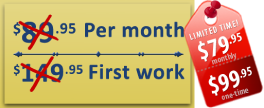Budgeting: Simple Steps to Get you Started
TweetYou've heard over and over that following a budget is the first step towards achieving financial wellness. You know you need to do it, but it's often easier said than done. Putting together a realistic yet user-friendly budget takes time, willingness, motivation and discipline.
Even though the process can seem daunting, it can become much easier if broken into steps.
Step 1: Just start
Start somewhere. Your stress about creating a budget will be drastically reduced by simply taking a few minutes to learn about money management and how to get your personal finances under control. Or you could start by writing down how much you think you spend on certain things like: eating out, entertainment, clothing, recreation, and so on. Next to your estimate, write down how much you would like to spend in each of these areas. This will help you gain clearer perspective as your spending plan unfolds.
Step 2: Identify where your money is going
Even if you can't account for everything, look over your bills and receipts for the past few months to see where your money is going. This will give you an idea where you are spending the majority of your income.
Step 3: Map out your information
This step can get a bit tedious. But hang in there, you are laying your foundation.
For at least one full month record all of your financial inflows and outflows. (One month is good to get you started but you may want to map out this info for a couple more months to get more accurate averages). Be sure to include large expenses that occur once or twice a year, such as car insurance and Christmas. Divide the amount by twelve, that way it is calculated into a monthly budget.
During this two- or three-month period, save every single receipt you get for any expense. If you don't normally ask for or keep receipts, do so during this period. Also, carry a small notebook to write down any cash transactions. As you're classifying expenses, notice that some of them are fixed, while others are more flexible.
Step 4: Get organized
This step requires the most amount of work. But, once you are done, things will get much easier. After you have mapped out transactions for a couple of months, sit down with all your records — all of your receipts, checkbook, pay stubs, credit card and bill statements, and notebook of cash transactions. You'll also need a method of recording and calculating. You can do it the old-fashioned way with a pad of paper, a pen or pencil, and a calculator or you can use one of the many software programs available. Use whatever is easiest and will keep you motivated.
Start making lists of all the inflows and outflows. Group them into categories and total the amounts for each item. There are many examples of spreadsheets and category trackers on-line. Then calculate what percentage of your income is spent on what category.
Step 5: Evaluate
Upon evaluating your spending and saving habits, chances are you will identify many areas that could use improvement. Find areas where you can cut back. Many software programs can tell you exactly where you can cut back, taking the guess-work out of it. The flexible expenses can be reduced. Even the fixed expenses may be negotiated. You could refinance your mortgage, talk to your creditors about reducing your interest, or switch to a cheaper insurance policy.
Step 6: Be Flexible
Sounds a bit contrary, we know. Budgeting is all about being organized, disciplined, meticulous, structured, and so on. What we mean by be flexible is don't miss the bigger picture by being overly focused and concerned with the smaller details. Or as the saying goes, "stepping over dollars to get to pennies."
If you are spending all of your time and energy accounting for every little penny rather than the cost, timing and frequency of larger expenses like a car or home, you're not going to see great results. True, you can save by cutting back on monthly incidentals, but make sure you are looking out for the big purchases first; then turn to the smaller issues.
Also, don't be so rigid with categories that there is no give. Let's say you have been good about eating at home and there is a surplus in your 'Dining Out', or 'Food', category. And then you see the pair of boots you've been wanting for months on sale for a great price. Looking over your budget, you see there is nothing left in your clothing category; does that mean you don't get to buy the boots? You could take the surplus from your food category (or another surplus area) and put in your clothing category; and then the boots fit in your budget. Conversely, ask yourself how much you really need or want the boots. You may find more satisfaction in putting that surplus towards savings or a credit card bill instead? The possibilities are endless; so be open and flexible while keeping the bigger picture in mind.
Getting organized and becoming more conscious of your spending habits will go a long way in helping you get in control and get out of debt.



